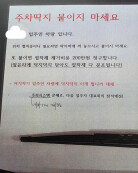Unveiling of Restored Traditional Gate Set for Aug. 15
Unveiling of Restored Traditional Gate Set for Aug. 15
Posted July. 02, 2010 11:56,
The restoration of the traditional gate Gwanghwamun is 90 percent complete and will be unveiled on the occasion of Liberation Day August 15, culture officials said Thursday.
Above a stone structure was a newly built two-storied wooden tower, with painting work also almost complete. The restoration of the walls from east to west was also nearly done and that of attached buildings was in its final stage.
Master carpenter Shin Eung-su, a living national treasure in charge of the restoration, said, "Weve especially done an elegant job in making the curved line of a tiled roofs eaves."
The Cultural Heritage Administration will begin removing the temporary cover over Gwanghwamun Monday and finish the work by late this month. After the cover is taken off, people can see the final touches on the restoration work. A signboard with the same calligraphy used in the 1865 restoration will be hung at the end of the month.
Reconstructed buildings set for unveiling on Liberation Day will include attached buildings to Gwanghwamun such as palace walls and a building for gatekeepers, a royal passage to the entrance Heungryemun behind Gwanghwamun, and part of Waldae in front of it. The restoration of palace walls will continue after the unveiling.
Gwanghwamun was built as the main gate of Gyeongbok Palace in 1395, but was burned down in 1592 when Japan invaded the Korean Peninsula. In 1865 under the reign of King Gojong, the gate was restored by Heungseon Daewongun along with the palace.
In 1926, the Japanese imperial government relocated the gate to north of Geonchunmun, which is the site of the National Folk Museum, to make way for an office building.
The wooden tower on the rampart disappeared in the Korean War.
In 1968, the Korean government tried to relocate the gate to its original site but ended up locating it 10 meters away from it. The gate was twisted 3.75 degrees from the central axis and its tower on the stone structure was made of concrete.
Restoration work this time aims to correct the location and has used wood to make the tower. Completion will mark the end of the first-stage restoration of Gyeongbok Palace that began in 1990.
kplee@donga.com






![트럼프의 그린란드 병합 의지, ‘이 사람’이 불씨 지폈다[지금, 이 사람]](https://dimg.donga.com/c/138/175/90/1/wps/NEWS/IMAGE/2026/01/20/133193287.1.jpg)
